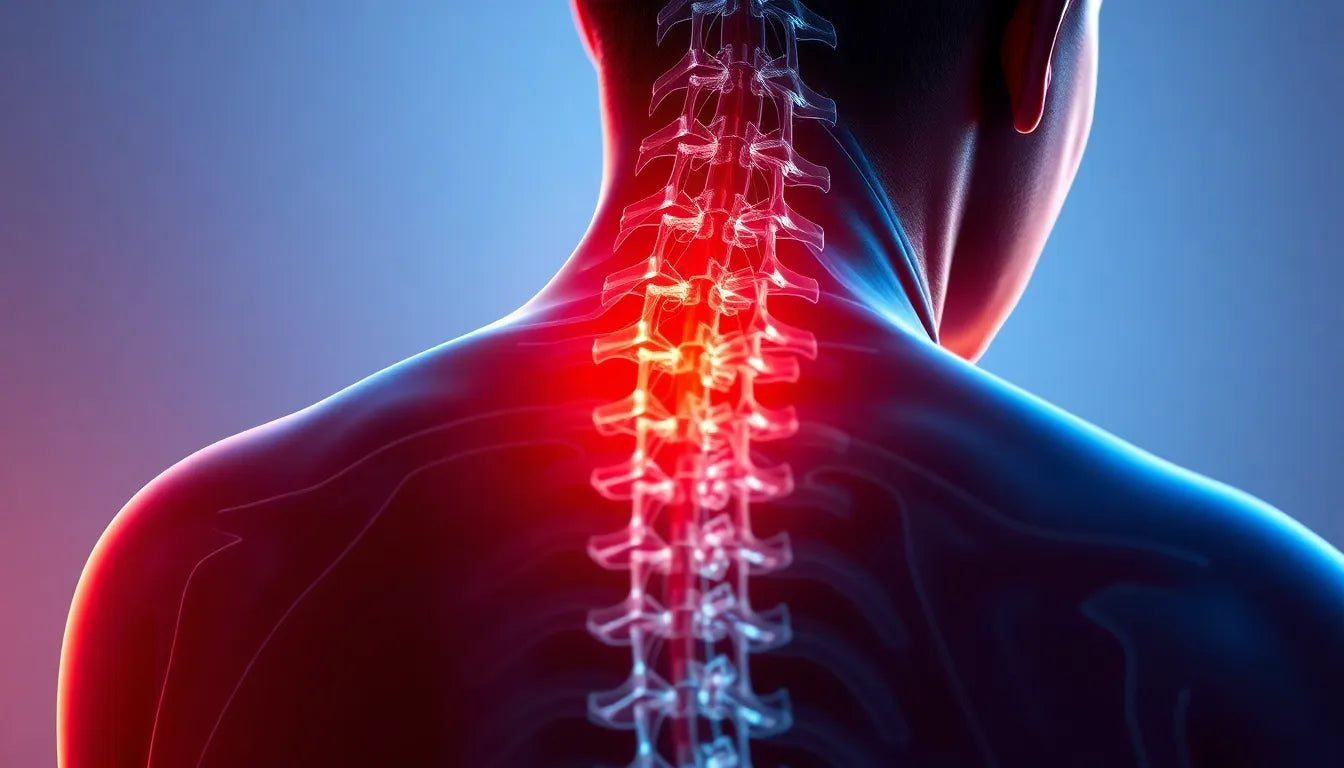Imagine waking up one morning with a dull ache in your lower back, a sensation you're somewhat accustomed to if you have a history of back issues. However, as the day progresses, you begin to experience a peculiar and unexpected discomfort in your abdomen. Puzzled, you wonder if the two could possibly be related. This is a scenario that many might find surprising, as abdominal pain is not commonly associated with spinal problems. Yet, it is indeed possible for a herniated disc, particularly in the thoracic spine, to lead to such symptoms.
Understanding the connection between back pain and abdominal discomfort
Back pain is often linked to spinal issues, such as herniated discs, which occur when the soft inner core of a spinal disc pushes through a crack in its tougher exterior. While this condition is typically associated with pain or numbness in the back, legs, or arms, it can sometimes manifest in unexpected ways. One of these is abdominal pain, a symptom that can bewilder those who experience it, especially when it seems unrelated to their known back problems.
The thoracic spine, which runs from the base of the neck to the abdomen, is a less common site for disc herniation compared to the cervical or lumbar regions. However, when a disc herniates in this area, it can impinge on the nerves that serve the abdominal region, potentially leading to discomfort or pain in the abdomen. Although this occurrence is rare, it demonstrates the complex interplay between different parts of the body and how an issue in one area can manifest symptoms in another.
Purpose of exploring this link
The aim of this blog post is to delve deeper into the connection between herniated discs and abdominal pain, shedding light on this unusual yet possible link. By understanding the symptoms, causes, and available treatment options, individuals can gain clarity and seek appropriate medical advice if they suspect their abdominal discomfort may be related to a spinal issue. This exploration not only provides insights into the condition but also underscores the importance of considering spinal causes when faced with unexplained abdominal pain.
In the following sections, we will further explore the nature of herniated discs, particularly in the thoracic spine, and discuss the potential causes and risk factors. We will also highlight the symptoms to watch for and the challenges in diagnosing this condition. Understanding these aspects is crucial for anyone who may be experiencing these perplexing symptoms, ensuring they receive the right diagnosis and treatment.
Understanding herniated discs and their impact on the thoracic spine
A herniated disc occurs when the inner gel-like core of a spinal disc leaks out through a tear in its tougher outer layer. This condition is more common in the lumbar and cervical regions of the spine. However, when it happens in the thoracic spine, the implications can be unique and sometimes perplexing, particularly regarding abdominal discomfort.
The thoracic spine is composed of 12 vertebrae located between the neck and the lower back. When a disc herniates in this area, it can exert pressure on the nearby nerves. These nerves, part of the complex network that controls various bodily functions, can transmit pain signals to the abdomen, resulting in abdominal pain. This phenomenon highlights how interconnected our bodily systems are, with an issue in one area potentially affecting another seemingly unrelated area.
Causes and risk factors for thoracic disc herniation
Several factors can contribute to the herniation of a disc in the thoracic spine. Trauma is a significant cause, whether from a fall, accident, or any impactful event that stresses the spine. Degenerative disc disease, a condition where discs deteriorate over time, can also lead to herniation. Additionally, specific movements, such as twisting or reaching awkwardly, can exacerbate the condition, especially in individuals predisposed to spinal issues.
Interestingly, research indicates that women are more frequently affected by thoracic disc herniation than men. This gender difference in prevalence may be due to anatomical and physiological variations, but further studies are needed to fully understand why this disparity exists.
Recognizing the symptoms of thoracic disc herniation
Identifying the symptoms of thoracic disc herniation is crucial for timely and accurate diagnosis. Common symptoms include:
- Abdominal pain: This can range from mild discomfort to severe pain, often mistaken for gastrointestinal issues.
- Mid-back pain: A persistent ache or sharp pain in the middle of the back.
- Chest pain: Sometimes, the pain can radiate to the chest, mimicking heart conditions.
- Bloating and digestive issues: The pressure on nerves can disrupt normal digestive functions, leading to bloating or changes in bowel habits.
To provide clarity, here is a comparison table of symptoms between thoracic disc herniation and other common causes of abdominal pain:
| Condition | Symptoms |
|---|---|
| Thoracic Disc Herniation | Abdominal pain, mid-back pain, chest pain, bloating |
| Irritable Bowel Syndrome | Abdominal pain, bloating, changes in bowel habits (diarrhea or constipation) |
Diagnosis challenges and the importance of medical evaluation
Diagnosing thoracic disc herniation can be challenging due to its rarity and the overlap of symptoms with more common conditions like irritable bowel syndrome. Misdiagnosis is a risk, leading to unnecessary tests and treatments that do not address the root cause of the symptoms.
Therefore, a thorough medical evaluation is essential. Healthcare professionals may use diagnostic imaging, such as MRI or CT scans, to visualize the spine and identify any herniated discs. This approach ensures that the correct diagnosis is made, allowing for appropriate treatment to be administered, ultimately alleviating the patient's symptoms and improving their quality of life.
Treatment options for thoracic disc herniation
When dealing with the complexities of thoracic disc herniation, it's crucial to explore a range of treatment options tailored to the individual's specific condition and needs. The initial approach often involves conservative measures, such as pain relief medications and physical therapy. These treatments aim to alleviate symptoms and improve mobility without invasive procedures. Physical therapy, in particular, can strengthen the muscles supporting the spine, potentially reducing pressure on the affected disc.
In more severe cases, where conservative treatments fail to provide relief, surgical interventions may be considered. Surgery might involve removing the herniated portion of the disc or, in some instances, spinal fusion to stabilize the affected area. It's essential for patients to consult with healthcare professionals to determine the best course of action, considering both the potential benefits and risks of surgery.
Case studies and research insights
Research into thoracic disc herniation has highlighted its role in chronic abdominal pain, often overlooked in diagnostic processes. Studies published in medical journals emphasize the need for awareness among healthcare providers to consider spinal causes when evaluating unexplained abdominal symptoms. A notable case study detailed a patient's journey, initially misdiagnosed with gastrointestinal issues, who eventually found relief after the correct diagnosis of thoracic disc herniation and appropriate treatment.
This research underscores the importance of comprehensive medical evaluations and the potential for improved patient outcomes when spinal conditions are accurately identified and treated.
Conclusion
Understanding the link between back pain and unexpected abdominal discomfort is crucial for both patients and healthcare providers. Recognizing that a herniated disc, particularly in the thoracic spine, can manifest as abdominal pain helps ensure a more accurate diagnosis and effective treatment plan. If you experience persistent abdominal discomfort alongside back pain, seeking professional medical advice is essential. This approach not only alleviates symptoms but also enhances overall quality of life by addressing the root cause of the discomfort.
Frequently Asked Questions
Can a herniated disc cause digestive issues?
Yes, particularly if the herniation affects nerves connected to the digestive system, leading to symptoms like bloating or changes in bowel habits.
How common is it for a herniated disc to cause abdominal pain?
It is relatively rare, but possible, especially with herniation in the thoracic spine.
What should I do if I suspect my back pain is related to abdominal discomfort?
Consult a healthcare professional for a comprehensive evaluation to determine the underlying cause and appropriate treatment.
Are there specific tests to diagnose a herniated disc causing abdominal pain?
Diagnostic imaging such as MRI or CT scans can help identify herniated discs and their potential impact on surrounding nerves.
Can lifestyle changes help manage symptoms associated with herniated discs?
Yes, lifestyle changes such as maintaining a healthy weight, practicing good posture, and engaging in regular physical activity can help manage symptoms.


















